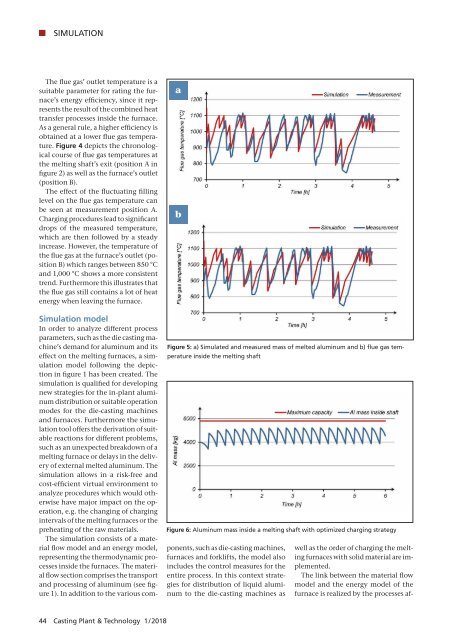CPT International 01/2018
- No tags were found...
Create successful ePaper yourself
Turn your PDF publications into a flip-book with our unique Google optimized e-Paper software.
SIMULATION<br />
The flue gas’ outlet temperature is a<br />
suitable parameter for rating the furnace’s<br />
energy efficiency, since it represents<br />
the result of the combined heat<br />
transfer processes inside the furnace.<br />
As a general rule, a higher efficiency is<br />
obtained at a lower flue gas temperature.<br />
Figure 4 depicts the chronological<br />
course of flue gas temperatures at<br />
the melting shaft’s exit (position A in<br />
figure 2) as well as the furnace’s outlet<br />
(position B).<br />
The effect of the fluctuating filling<br />
level on the flue gas temperature can<br />
be seen at measurement position A.<br />
Charging procedures lead to significant<br />
drops of the measured temperature,<br />
which are then followed by a steady<br />
increase. However, the temperature of<br />
the flue gas at the furnace’s outlet (position<br />
B) which ranges between 850 °C<br />
and 1,000 °C shows a more consistent<br />
trend. Furthermore this illustrates that<br />
the flue gas still contains a lot of heat<br />
energy when leaving the furnace.<br />
a<br />
b<br />
Figure 5:perature<br />
inside the melting shaft<br />
Figure 6: Aluminum mass inside a melting shaft with optimized charging strategy<br />
Simulation model<br />
In order to analyze different process<br />
parameters, such as the die casting machine’s<br />
demand for aluminum and its<br />
effect on the melting furnaces, a simulation<br />
model following the depiction<br />
in figure 1 has been created. The<br />
simulation is qualified for developing<br />
new strategies for the in-plant aluminum<br />
distribution or suitable operation<br />
modes for the die-casting machines<br />
and furnaces. Furthermore the simulation<br />
tool offers the derivation of suitable<br />
reactions for different problems,<br />
such as an unexpected breakdown of a<br />
melting furnace or delays in the delivery<br />
of external melted aluminum. The<br />
simulation allows in a risk-free and<br />
cost-efficient virtual environment to<br />
analyze procedures which would otherwise<br />
have major impact on the operation,<br />
e.g. the changing of charging<br />
intervals of the melting furnaces or the<br />
preheating of the raw materials.<br />
The simulation consists of a material<br />
flow model and an energy model,<br />
representing the thermodynamic processes<br />
inside the furnaces. The material<br />
flow section comprises the transport<br />
and processing of aluminum (see figure<br />
1). In addition to the various components,<br />
such as die-casting machines,<br />
furnaces and forklifts, the model also<br />
includes the control measures for the<br />
entire process. In this context strategies<br />
for distribution of liquid aluminum<br />
to the die-casting machines as<br />
well as the order of charging the melting<br />
furnaces with solid material are implemented.<br />
The link between the material flow<br />
model and the energy model of the<br />
furnace is realized by the processes af-<br />
44 Casting Plant & Technology 1 / 2<strong>01</strong>8


















